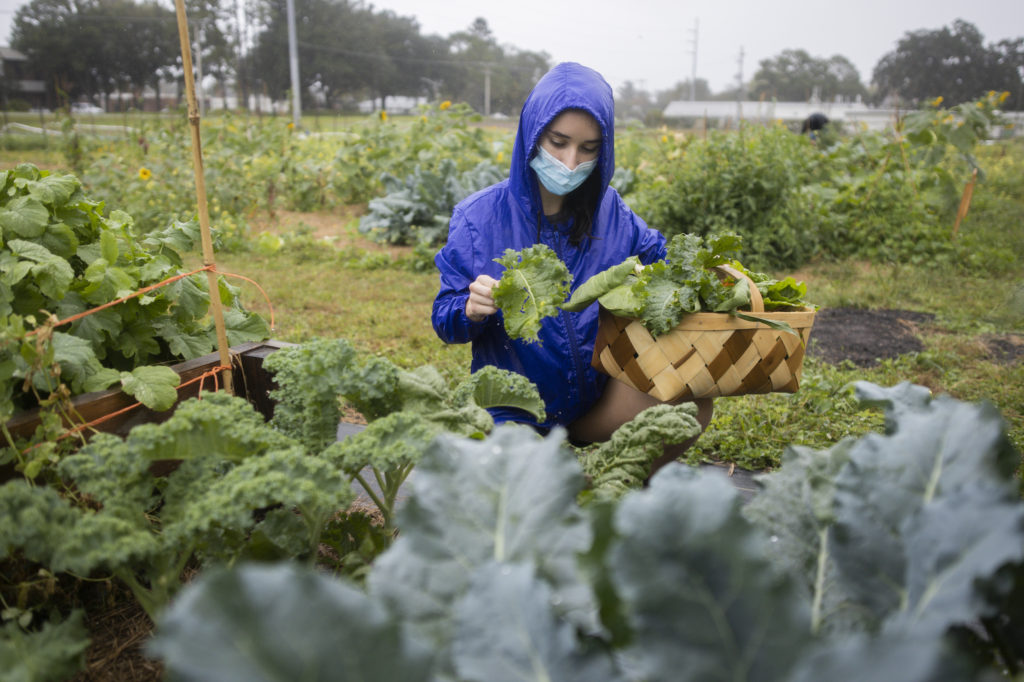
Horticultural sciences student working garden plots at the UF teaching farm.
In response to disruptions to food supply chains caused by COVID-19, the PIE Center collaborated with the Center for Rural Enterprise Engagement (CREE) to conduct research on positioning regional food supply chains for future pandemics, natural disasters and human-made crises.
The research project was one of 17 projects nationwide to receive funding through a new program area of the United States Department of Agriculture’s (USDA) Agriculture and Food Research Initiative (AFRI). The program promotes rapid response solutions to the pandemic through applied research, education and extension activities.
The project’s goal was to assess the impact of COVID-19 on farm and food supply chain operations by understanding consumers’ behavioral responses regionally and across the U.S. Researchers wanted to understand the capacities and structural vulnerabilities of regional food systems to support population needs, develop resources and strategies for current and future disruptions with supply chain stakeholders and offer training programs for university cooperative extension personnel to strengthen support for local and regional supply chain participants during times of disruption.
Lauri Baker, associate professor of agricultural education and communication, and PIE Center research coordinator Anissa Zagonel have been leading this project.
“This project has been a great way to bring together researchers from universities across the United States,” Baker said. “This type of interdisciplinary research has allowed us to better assess the perceptions and needs of producers in the U.S.”
The project has brought together five universities from three regions of the country: the North Central region, the Southeast region and the Southwest region. The universities that represent these regions are the University of Minnesota, Kansas State University, University of Wisconsin-Madison, University of Florida and University of California-Irvine.
Over the course of this project, researchers conducted surveys and an environmental scan, held three webinars and worked to disseminate the results with the public. Surveys examined how producers adapted to shorter, regional supply chains during COVID-19.
An online survey was implemented across three USDA regions in the United States. Data for the first survey were collected from Feb. 1 to April 15, 2021. The second survey is still collecting data.
Findings from the first survey indicated that 43% of respondents perceived a relative advantage to adopting a shorter supply chain during COVID-19. Nearly 54% of respondents indicated that shorter, regional supply chains aligned with their businesses and personal values. Twenty percent of respondents indicated that the transition to a shorter supply chain was complex.
When respondents were asked about their ability to observe others transitioning to a shorter, regional supply chain, only 19% of respondents indicated being able to observe. When asked about top sources of information related to shorter, regional supply chains, respondents indicated that their top sources were commodity/grower/ industry associations, friends or family members and neighbors and community members.
“Being able to provide information and insight on how the regional food supply chains can be more resilient in the future in the event of another disaster, whether it be a major weather event or another pandemic, is really important,” Zagonel said. “If we are able to do this, then this project will be a success.”
The team plans to create training programs for university cooperative extension personnel, conduct additional webinars, create and distribute fact sheets highlighting research efforts and produce additional resources focused on the lessons learned from COVID-19.
“We are excited for the future of this project,” Baker said. “We have several other data collection, deliverables, presentations and trainings planned for the remainder of this project.”
This story is featured in this year’s annual report.
















